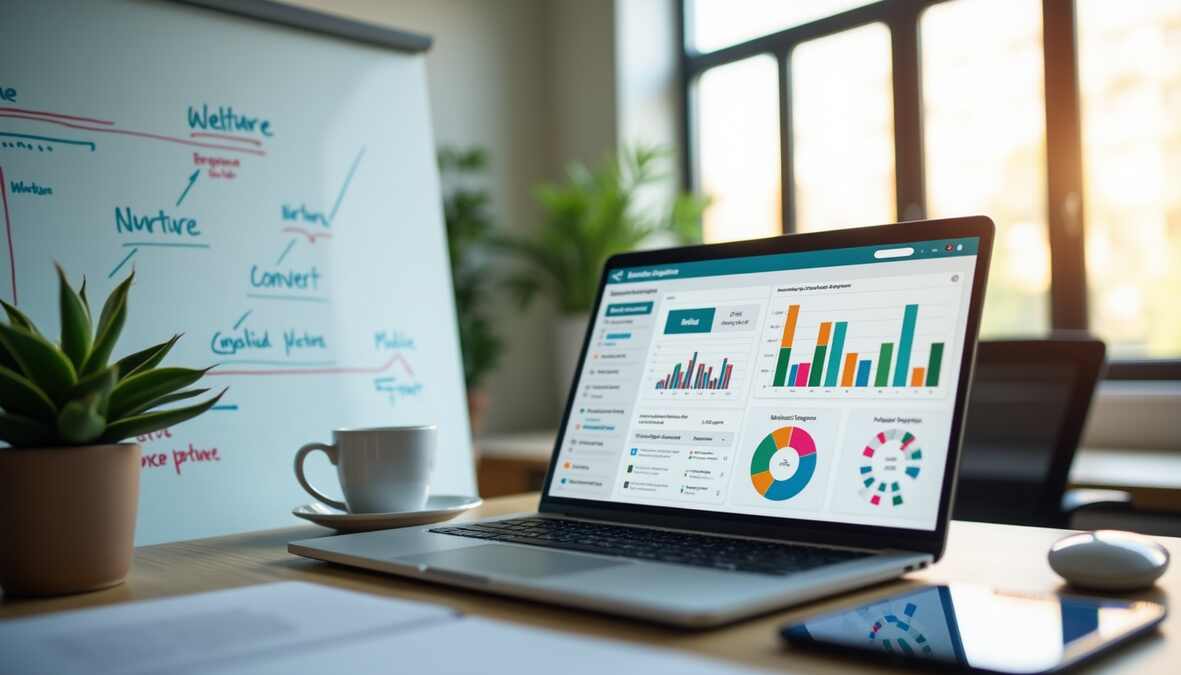Sales Email: Did you know that 92% of salespeople give up after four ‘nos,’ but 80% of prospects say ‘no’ four times before they say ‘yes’? Creating effective sales email templates could be the difference between missed opportunities and closed deals.
Despite the fact that 25% of sales emails never reach their destination, email remains one of the most powerful sales tools available. According to Litmus, the average return on email marketing is $36 for every dollar invested. However, success requires more than persistence—it demands well-crafted messages that speak directly to your prospects’ needs. The best sales email templates combine personalization, conciseness, and compelling calls to action to drive responses.
In this comprehensive guide, we’ll share how to write sales emails that get responses, breaking down the essential elements of high-converting messages. Whether you’re looking for a sales introduction email template or proven B2B sales email templates, we’ll provide practical examples and actionable strategies to help you connect with prospects and close more deals in 2025.
The 7 Key Elements of a Sales Email That Gets Responses
Creating a sales email that actually gets responses isn’t about flashy gimmicks or pushy tactics. Instead, it’s about crafting messages that resonate with your recipients and make it easy for them to engage. Let’s break down the seven critical elements that turn ordinary sales emails into response-generating machines.
1. A subject line that grabs attention
Your subject line serves as the gateway to your email—47% of recipients decide whether to open an email based solely on this crucial first impression. Effective subject lines are concise, with research indicating that 41 characters (approximately seven words) capture attention most effectively.
For optimal results, Campaign Monitor suggests keeping subject lines around 41 characters to ensure they display properly across desktop, mobile, and tablet devices. Additionally, research from Regie.ai found that subject lines with exactly seven words enjoy the highest open rates.
Rather than using generic phrases like “Meeting Request,” opt for specific benefit-oriented language such as “Quick chat to discuss employee retention”. Personalization is particularly powerful—adding the recipient’s name can increase revenue by an average of 20%.
2. A personalized opening line
Once your subject line has done its job, your opening line must maintain momentum. This is your opportunity to demonstrate that you understand your prospect as a person, not just an item on your to-do list. A strong opening immediately establishes why you’re reaching out and creates a connection.
Many effective opening lines begin with a personal connection, often using a first-person statement. You might mention a mutual contact who referred you or acknowledge a recent accomplishment by the prospect. Remember, it’s unnecessary to introduce yourself in the opening if your email address appears above the subject line.
3. A clear and concise body
The body of your email should deliver a concise message that clearly articulates the benefits your product or service offers. According to Boomerang data, emails between 50 and 120 words receive the highest open rates.
Focus on benefits rather than features, tailoring your message to address the specific pain points of your prospect. Show them you understand their challenges and demonstrate how your solution provides tangible value. Keep your message upbeat and professional while avoiding jargon that might confuse recipients.
4. A compelling call to action
Every sales email must contain an obvious and actionable CTA. The most effective CTAs are simple, straightforward requests that move the conversation forward. End every email with a clear call-to-action that leaves no room for ambiguity about which action you want your prospect to take.
For colder leads, include a soft CTA like downloading a free resource rather than pushing for an immediate sale. For warmer prospects who already know your product, consider using multiple CTAs—such as a pricing link and a phone number—to provide conversion options.
5. A professional signature
Your email signature serves as your digital business card and often forms your first impression. Beyond basic contact information, an effective signature can include:
- A link to your calendar to avoid endless email chains about scheduling
- Customer reviews or testimonials to leverage social proof
- Your latest publications or blog posts to showcase expertise
- A professional headshot to humanize your communication
Remember, signatures with real names create personal connections much more effectively than company names alone.
6. Smart timing and delivery
When you send your sales emails significantly impacts engagement. Research analyzing 14 different studies found that Tuesday consistently earns the best results, followed by Thursday and Wednesday. Regarding time of day, late morning (between 9-11am) achieves the highest open rates at around 7%.
Avoid sending sales emails on weekends or outside normal business hours (before 8am or after 8pm). Experiment with timing to find what works best for your specific audience, as response patterns may vary by industry and recipient type.
7. A value-driven follow-up
Finally, your follow-up strategy can make or break your sales efforts. Effective follow-ups offer value rather than simply checking in. Pack these emails with relevant information that addresses your prospect’s wants and needs.
For follow-ups, keep your message short but engaging—especially if leads have gone cold. Maintain a human touch by using an informal approach, such as signing with only your first name. Above all, avoid canned responses; if you must use templates, ensure they’re as friendly and personal as possible.
How to Write a Sales Email Step-by-Step
The difference between ignored sales emails and those that get enthusiastic responses often comes down to your process. Let’s break down the essential steps for creating sales email templates that consistently drive results.
Step 1: Research your prospect
Before writing your first word, invest time understanding who you’re contacting. According to sales research, understanding your customer base is like setting a GPS before starting a road trip—it ensures you reach the right destination.
Start by:
- Analyzing your existing customers to identify common traits
- Creating detailed buyer personas that guide your research
- Understanding the specific pain points your prospects face
Use tools like LinkedIn, CRM software, and lead generation platforms such as ZoomInfo or Clearbit to gather detailed information. This research prevents your email from sounding like a generic pitch you throw at every opportunity.
Step 2: Choose the right email structure
Selecting the appropriate email structure depends on your goal. Consider these proven approaches:
- Problem-Agitate-Solve (PAS): Identify a problem, emphasize consequences, then introduce your solution
- 3×3 Style: Find three valuable things about your prospects, then offer three solutions
- AIDA Method: Structure your email with Attention, Interest, Desire, and Action components
The ideal email length varies by context. While Boomerang research suggests emails between 50-125 words have response rates of nearly 50%, other studies found that 300-word emails can perform better for specific audiences.
Step 3: Write a strong subject line
Your subject line determines whether your email gets opened or deleted. In fact, 64% of recipients decide whether to open an email based solely on this crucial element.
For maximum impact:
- Keep it short (41-50 characters or about 7 words)
- Place important information at the beginning
- Include the prospect’s name (personalized subject lines are 26% more likely to be opened)
- Avoid special characters and all caps
Step 4: Personalize the opening
Your opening line must immediately demonstrate that this email was written specifically for the recipient. The more personalized, the better—generic introductions get ignored.
Reference the prospect’s company news, recent accomplishments, mutual connections, or even their LinkedIn profile information. This extra effort signals that you’ve done your homework.
Step 5: Focus on benefits, not features
Prospects care about what you can do for them—not how great your company is. The body of your email should clearly articulate how your product solves their specific challenges.
Focus on the outcomes they’ll experience rather than product specifications. For instance, instead of saying “Our software has an AI-powered inventory management module,” say “With our tool, you can slash inventory management time in half”.
Step 6: End with a clear CTA
A study by WordStream found that including a single CTA in an email increased clicks by an impressive 371%. Your call-to-action should:
- Be specific about the next step
- Remain simple and straightforward
- Create minimal friction for the recipient
- Match the relationship stage (softer CTAs for cold emails)
Remember that even minor CTA missteps can prevent targets from taking action. Make it easier for them to say yes than no.
Best Sales Email Templates for Different Scenarios
Even the most skilled sales professionals rely on tested templates as frameworks for different customer interactions. Having the right template for each scenario ensures you’re prepared for every stage of the sales journey.
Cold outreach email template
A standout cold email acknowledges the prospect’s achievements first, then bridges to how you can help. Keep it brief—3-5 sentences maximum.
Subject line: Are you doubling down on [goal]?
Hi [prospect name],
I checked out your website, and it looks like you might be trying to [accomplish X specific goal]. Without making assumptions about your business goals, I believe [Y] might play a pivotal role in your success.
If you’re unfamiliar with [company], our solution helps businesses in [prospect’s] space with:
- [Goal #1]
- [Goal #2]
- [Goal #3]
Are you free in the next few days to discuss [prospect company’s] strategy for [business area]?
Best, [Your name]
This template works because it focuses on their goals and success rather than your product features, drawing prospects into conversation.
Sales introduction email template
Subject line: Free trial of [software]
Hi [Prospect First Name],
I recently came across your question on [social media channel] about the best [product/service] and thought I would introduce myself.
Investing in the right [product/service] is important for companies like yours and requires: [list requirements here]
[Your product/service] offers a free trial that delivers insights into [XYZ].
Please don’t hesitate to reach out if you’d like to give it a try!
Best, [Your Name]
This approach works because it frames your introduction through the lens of solving a specific problem.
Follow-up sales email template
Subject: X helpful blog posts about [pain point]
Hi [Prospect First Name],
I wanted to reach out and let you know about several informative blog posts that I believe would be helpful for [prospect pain point]:
[Resource 1] [Resource 2] [Resource 3]
When you have a few minutes, check them out and let me know your thoughts!
Thank you, [Your Name]
Use this template when following up after a previous email if the prospect hasn’t responded, providing value rather than simply checking in.
Re-engagement email template
Subject: Is it goodbye, or can we win you back?
Hi [Subscriber’s Name],
Goodbyes are hard. But if you decide it’s time to move on, we understand.
However, before you go, here’s a special offer just for you: Get 30% Off Your Next Purchase – Use Code “STAY30”
If you still wish to part ways, you can unsubscribe here.
Thank you, [Your Name]
This email presents a final effort to retain the subscriber, balancing persuasion with respect for their choices.
Exclusive offer email template
Subject: Special offer just for you [Recipient’s name]!
Hi [Recipient’s Name]!
We’ve noticed you’ve been away for a while. To welcome you back, we’ve created a special offer just for you!
Enjoy a special discount on your next purchase. Use Code: “WELCOMEBACK”
Cheers, [Your Name]
This template capitalizes on pricing incentives to “lure” back subscribers, creating a sense of importance and urgency that encourages re-engagement.
Post-sale relationship email template
Subject: Welcome to [Your Company Name]
Hi [Customer Name],
We’re very excited to have a new partnership with your team!
I’ve included [Customer Success Rep Name] on this email to assist you with the onboarding process, but I’m happy to address any concerns or questions you may have.
To help with onboarding, here are a few resources to get you acquainted with [product/service]: [Resource 1] [Resource 2] [Resource 3]
We’re looking forward to assisting [Customer Company Name] with [pain point].
Best, [Your Name]
Send this message after securing a sale to show you’re still invested in their success, building trust and increasing the likelihood of future purchases.
Sales Email Best Practices for 2025
As we look toward 2025, mastering the technical aspects of email outreach becomes just as important as crafting compelling messages. Let’s explore the practices that will define successful sales emails in the coming year.
Use AI to generate and test variants
The future of sales emails is increasingly AI-driven, with 95% of marketers who use generative AI for email creation rating it “effective”. AI tools can dynamically adjust content based on recipient behaviors, helping you create personalized messages at scale.
For optimal results, provide AI with specific instructions about tone, audience, and pain points rather than generic prompts. Remember, AI is meant to optimize your workload, not replace you—though 60% of marketers still feel threatened by this technology.
Segment your email list by intent
Email segmentation allows you to tailor content specifically for subscribers, customers, and prospects. Furthermore, this approach helps you leverage intent data effectively, improving overall retention rates.
Consider segmenting based on:
- Purchase history and browsing patterns
- Content engagement levels
- Loyalty tier status
- Position in the sales qualification process
Analyzing behavioral data within your CRM reveals valuable insights—for instance, frequent visits to your pricing page might indicate pricing concerns you can address proactively.
Avoid spammy language and formatting
Emails containing certain trigger words are more likely to be filtered into spam folders. Consequently, this affects delivery rates and brand reputation—nonprofits alone lose nearly $15,000 annually in donations due to spam filters.
Avoid words that sound desperate (“please click here”), pushy (“act now”), or outlandish (“100% free”). Likewise, steer clear of all-caps subject lines, excessive exclamation points, embedded forms, and attachments.
Track open, reply, and conversion rates
While open rates have traditionally been a primary metric, Apple’s Mail Privacy Protection has made this less reliable. Therefore, focus on click-through rates (average is slightly over 2%) and conversion rates, which measure how many people completed your desired action after clicking.
Use social proof and case studies
Social proof dramatically increases email effectiveness—adding customer testimonials, reviews, or case studies boosts confidence in your offering. In fact, 63% of consumers state they’re more likely to purchase from a site with product reviews and ratings.
Incorporate “interest signals” showing how many others engaged with specific products, or use customer testimonials in your email signature to build credibility. Additionally, highlighting awards your company has received can significantly increase conversions.
How to Measure and Improve Your Sales Emails
Measuring your sales emails’ performance isn’t just about tracking numbers—it’s about understanding what drives prospects to respond. Without proper analytics, you’re essentially sending messages into the void.
Open rate and what it tells you
The average email open rate across industries hovers around 36.24% in 2024. This metric helps evaluate your subject line effectiveness and sender reputation. Despite Apple’s Mail Privacy Protection affecting accuracy, open rates remain valuable when analyzed over time.
A sudden drop might indicate:
- Technical delivery issues
- Subscriber fatigue
- Content that no longer resonates
Remember, timing matters—Tuesday consistently yields the highest open rates, while mornings between 9-11am see engagement peak at around 7%.
Reply rate vs. positive reply rate
Your reply rate measures the percentage of recipients who respond to your emails. Yet, not all replies are created equal. Using artificial intelligence, you can categorize responses as:
- Positive responses (prospects ready to engage)
- Objections (prospects with specific concerns)
- Unsubscribe requests (prospects opting out)
One-to-one personalization more than doubles reply rates for non-managerial prospects, whereas company-based personalization triples response rates from executives. Most importantly, referencing a prospect’s buying journey activities correlates with an 88% increase in replies.
Click-to-open rate (CTOR)
CTOR measures engagement quality by calculating: (Number of unique clicks ÷ Number of unique opens) × 100.
Unlike open rates, CTOR reveals whether your content motivated action after opening. The average CTOR across industries is approximately 10.5%, with 20-30% considered excellent.
If you notice high open rates but low CTOR, your subject lines work, but your content needs improvement.
Objection and unsubscribe rates
Monitor your unsubscribe rate—calculated as (Number of unsubscribes ÷ Number of emails delivered) × 100. Industry standards suggest keeping this below 1%, with rates above 2% considered problematic.
For objections, track five common types: already has a solution, bad timing, wrong person, budget concerns, and unspecified reasons. On average, it takes three touches and two weeks after a “bad timing” objection to achieve a positive response.
Using analytics to refine your approach
Effective analysis requires examining trends rather than isolated metrics. Consider:
- Segmenting data by recipient characteristics
- Comparing performance across different templates
- A/B testing subject lines and content elements
When metrics indicate problems, don’t hesitate to revise your approach. Essentially, analytics should drive continuous improvement—not just measurement for its own sake.
Conclusion
Crafting effective sales emails remains both an art and a science. Throughout this guide, we’ve explored strategies that transform ordinary messages into response-generating assets. These techniques undoubtedly work—remember that personalized emails deliver 20% more revenue, while well-crafted CTAs can boost clicks by 371%.
The most successful sales professionals understand that email success demands more than clever wordplay. Your messages must demonstrate genuine research, address specific pain points, and provide clear value to recipients. Timing matters equally—emails sent Tuesday mornings between 9-11am consistently outperform those delivered at other times.
Sales email templates serve as valuable frameworks, not rigid scripts. Therefore, always customize your approach based on recipient research and your specific offering. Additionally, regular testing and refinement based on reply rates, CTOR, and objection patterns will continuously improve your results.
Finally, remember that persistence pays off—80% of prospects say “no” four times before saying “yes,” yet most salespeople abandon their efforts after the fourth rejection. Armed with the templates, best practices, and measurement techniques covered in this guide, you now possess everything needed to create sales emails that generate meaningful responses throughout 2025 and beyond.
FAQs
Q1. What are the key elements of an effective sales email? An effective sales email includes a compelling subject line, personalized opening, concise body focused on benefits, clear call-to-action, professional signature, strategic timing, and value-driven follow-ups.
Q2. How long should a sales email be? The ideal length for a sales email is between 50 and 125 words. This range has been shown to receive the highest response rates, striking a balance between providing enough information and maintaining the reader’s attention.
Q3. What’s the best day and time to send sales emails? Tuesday is consistently the most effective day for sending sales emails. The optimal time is late morning, between 9-11 AM, when open rates peak at around 7%.
Q4. How can I improve my email open rates? To improve open rates, craft attention-grabbing subject lines (around 41 characters or 7 words), personalize content, segment your email list, and avoid spam trigger words. Also, regularly clean your email list and monitor your sender reputation.
Q5. What metrics should I track to measure sales email effectiveness? Key metrics to track include open rates, click-to-open rates (CTOR), reply rates (especially positive replies), conversion rates, and unsubscribe rates. Also, pay attention to objection patterns to refine your approach over time.
Read more: GTA 5 Rockstar


![How to Write Sales Email Templates That Actually Get Responses [2025 Guide] Sales Email](https://cgty.xyz/wp-content/uploads/2025/05/Sales-Email-150x150.jpg)







